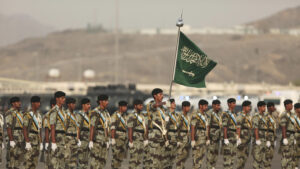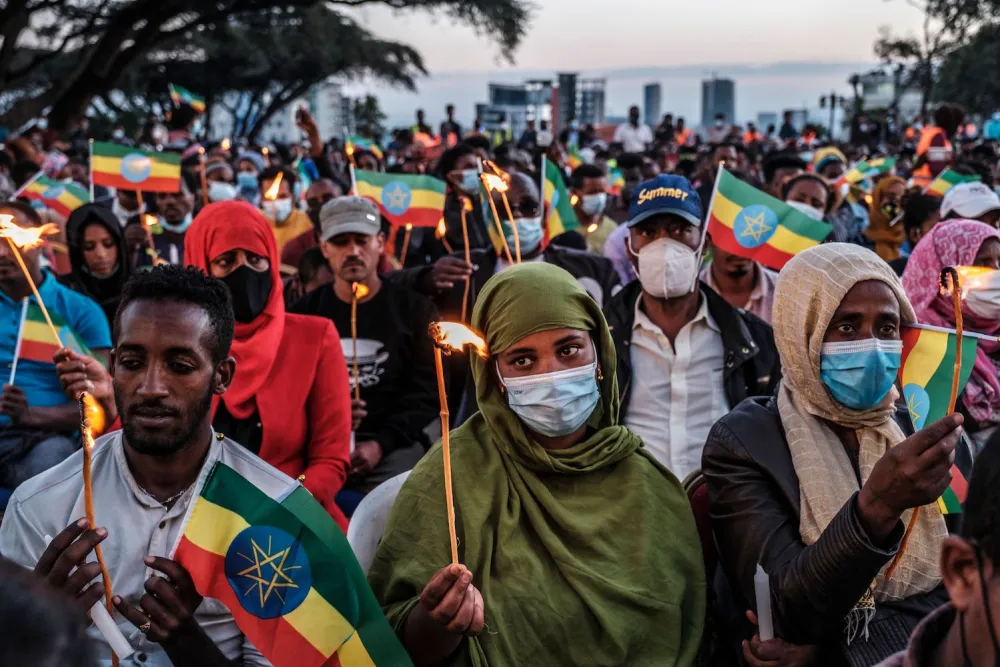Saudi Forces Accused of Killing Hundreds of Ethiopian Migrants Fleeing Yemen Conflict Amidst Escalating Ethiopian Civil Unrest
Saudi security forces have reportedly killed numerous Ethiopian migrants and asylum seekers attempting to cross the border with Yemen in search of safety amid the ongoing conflict that has caused extensive loss of life and property. Human Rights Watch (HRW) has raised serious concerns about the alleged abuses, stating that the Saudi forces have engaged in shooting people at close range and using explosive weapons against groups in the mountains. HRW suggests that these actions could potentially amount to crimes against humanity if carried out as part of a deliberate government policy.

In a recently released report, HRW detailed a widespread and systematic pattern of killings. The organization’s findings were based on witness accounts, along with the analysis of photos, videos, and satellite imagery dating back to 2021. The report implicates various Saudi forces, including border guards and specialized units, in the deaths of “hundreds, possibly thousands” of Ethiopians over recent years. Survivors and detainees have also allegedly been subjected to torture, rape, and other forms of inhumane treatment.
These alleged atrocities are taking place amidst conflicts in both Yemen and Ethiopia, which have contributed to migration from the Horn of Africa to the Arabian Peninsula. The outbreak of violent conflict in Ethiopia’s Tigray region in 2020 resulted in a humanitarian crisis, prompting millions to seek assistance due to conflict, drought, and hunger.
Human Rights Watch estimates that the majority of migrants traveling along the “Eastern Route” to Saudi Arabia are Ethiopians fleeing war, persecution, and hunger. This route begins in the Horn of Africa, crosses the Gulf of Aden, passes through war-torn Yemen, and ultimately leads to the challenging terrain of Saudi Arabia’s Jizan province. The report underscores the dire circumstances faced by migrants in search of safety and highlights the complex regional dynamics at play.
Ethiopian Jewish Activists Rally for Urgent Aliyah Rescue Amidst Gondar Conflict
Israeli citizens of Ethiopian descent and activists advocating for Ethiopian Jewish immigration staged a significant gathering outside the Prime Minister’s Office in Jerusalem on Sunday. Led by Surafel Alamo, coordinator of the Struggle to Save Ethiopian Jewry, the demonstrators sought immediate action to rescue eligible candidates for Aliyah from the conflict-stricken Gondar region.
Amidst ongoing clashes in Gondar and its environs, Alamo and his fellow protesters aimed to spotlight the critical predicament faced by those awaiting immigration in camps. Last week, Israel executed a rescue operation that brought over 200 Israeli and Ethiopian citizens to safety due to violent confrontations between the Ethiopian Army and the FANO militia. The joint effort by the Prime Minister’s Office and The Jewish Agency was executed through three planes, transferring Israeli citizens, Jewish Agency personnel, Project TEN volunteers, and eligible immigrants to Israel.
However, concerns were raised by the Struggle to Save Ethiopian Jewry, as over a thousand qualified individuals were left behind in Ethiopia during the recent rescue flight. These potential candidates for Aliyah were trapped in the besieged Gondar camp, a volatile environment where their safety and prospects for a new life were uncertain. The Israeli government contended that those who were Jewish or of Jewish descent had already completed aliyah, implying no further Jewish presence in Ethiopia.
Reports indicated that 4,226 individuals from Gondar and Addis Ababa camps had submitted Aliyah requests, highlighting the urgency of the situation. Escalating conflict across Ethiopia, particularly in Gondar, posed a grave threat to those awaiting Aliyah, underscoring the need for swift and robust action. Alamo and others emphasized that Israel’s historical commitment to rescuing Jews in crises necessitated a more substantial response to ensure the Ethiopian Jewish community’s safety and well-being.
Former Member of Knesset Dr. Avraham Neguise echoed these sentiments, stressing the moral obligation to prioritize lives and uphold their commitment to the Jewish people in times of such dire circumstances. As the conflict continues to unfold, pressure mounts on Israeli authorities to address the pressing need for the rescue of Ethiopian Jews amid the turmoil in Gondar.
Ethiopian Army Drone Targets Protesters in Amhara Region
Finote Selam,– A devastating incident shook Finote Selam in Ethiopia’s Amhara region as an army drone attacked protesters rallying against the impending arrival of federal forces.
Reports conflict on casualties, with local hospitals stating at least 26 deaths and over 70 injuries, while initial estimates reached 70 fatalities. The strike, motives unclear, has prompted calls for independent verification.
Tensions escalate in the Amhara region, with clashes between the Ethiopian army and the militia group Fano. The international community urges peaceful resolutions and protection of civilians amid mounting instability. This incident highlights the fragility of peace in Africa.
The civil conflict in Ethiopia
The civil conflict in Ethiopia’s Tigray region began in November 2020, involving various factions including ethno-regional militias, the federal government, and the Eritrean military. The Tigray People’s Liberation Front (TPLF) historically held power nationally despite being an ethnic minority. Prime Minister Abiy Ahmed Ali came to power in 2018, promising unity, but tensions escalated due to delayed elections and defiance by Tigrayan leadership.
The conflict intensified as military operations escalated, leading to a civil war known as the Tigray War. Abuses against civilians, ethnic cleansing, and mass atrocities were reported. Eritrean involvement in the conflict raised concerns, and efforts to address the crisis were hindered by geopolitics.
The conflict sparked a displacement crisis, and tensions spread to other regions with various ethnic groups getting involved. Concerns also arose about the impact on regional stability, especially related to negotiations over the Grand Ethiopian Renaissance Dam (GERD). Ceasefire attempts failed until negotiations led by the African Union (AU) resulted in a cessation of hostilities agreement between the Ethiopian government and TPLF. However, challenges persist, including tensions between regions, efforts to centralize power, and the withdrawal of foreign troops. Humanitarian aid access remains problematic, exacerbating the ongoing crisis.
Recent developments include clashes with the Fano militia in the Amhara region, allegations of neglect by the federal government, and a state of emergency declaration. The situation remains complex, with ongoing challenges and uncertainties.
https://madeinblacc.com/some-african-state-in-conflict/

Leave a Reply
You must be logged in to post a comment.